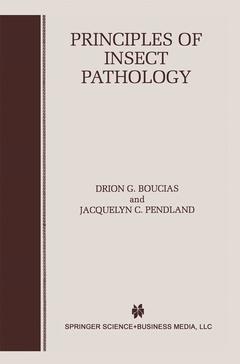Description
Principles of Insect Pathology, 1998
Authors: Boucias Drion G., Pendland Jacquelyn C.
Language: English
Subjects for Principles of Insect Pathology:
Keywords
Fungi imperfecti; insect; insect diseases; plant pathogens; zoology
Approximative price 421.99 €
In Print (Delivery period: 15 days).
Add to cart
Principles of Insect Pathology
Publication date: 09-2012
550 p. · 15.5x23.5 cm · Paperback
Publication date: 09-2012
550 p. · 15.5x23.5 cm · Paperback
Approximative price 305.17 €
Subject to availability at the publisher.
Add to cart
The principles of insect pathology
Publication date: 11-1998
550 p. · 15.5x23.5 cm · Hardback
Publication date: 11-1998
550 p. · 15.5x23.5 cm · Hardback
Description
/li>Contents
/li>Comment
/li>
Principles of Insect Pathology, a text written from a pathological viewpoint, is intended for graduate-level students and researchers with a limited background in microbiology and in insect diseases. The book explains the importance of insect diseases and illuminates the complexity and diversity of insect-microbe relationships. Separate sections are devoted to
Principles of Insect Pathology combines the disciplines of microbiology (virology, bacteriology, mycology, protozoology), pathology, and immunology within the context of the insect host, providing a format which is understandable to entomologists, microbiologists, and comparative pathologists.
- the major insect pathogens, their characteristics, and their life cycles
- the homology that exists among invertebrate, vertebrate, and plant pathogens
- the humoral and cellular defense systems of the host insect as well as the evasive and suppressive activities of insect disease agents
- the structure and function of passive barriers
- the heterogeneity in host susceptibility to insect diseases and associated toxins
- the mechanisms regulating the spread and persistence of diseases in insects.
Principles of Insect Pathology combines the disciplines of microbiology (virology, bacteriology, mycology, protozoology), pathology, and immunology within the context of the insect host, providing a format which is understandable to entomologists, microbiologists, and comparative pathologists.
Preface. 1. Insect-Pathogen Relationships. 2. General Features of Viral Disease Agents. 3. Major Groups of Insect Viruses. 4. Baculoviruses. 5. Characteristics of the Pathogenic Prokaryotes. 6. Insect Pathogenic Bacteria. 7. Bacillus Thuringiensis: Producer of Potent Insecticidal Toxins. 8. General Properties of Fungal Pathogens. 9. Entomopathogenic Fungi: `Perfect' Phyla. 10. Entomopathogenic Fungi: Fungi Imperfecti. 11. Insect Pathogenic Protozoa. 12. Phylum Microsporidia. 13. Insect Immune Defense System, Part I: Innate Defense Reactions. 14. Insect Immune Defense System, Part II: The Recognition of Nonself. 15. Insect Immune Defense System, Part III: Prophenoloxidase Cascade and Post-Attachment Processes of Phagocytosis.
'...the treatment is modern and mainly uses computerized information. The rich compilation of actually used terminology...will help molecular biologists and biochemists understand insect pathology- et vice versa. ...recommend the book as a "door opener" to modern insect pathology provided that it is used in conjunction with a classical text book on insect pathology.' European Journal of Entomology, 97 (2000)
© 2024 LAVOISIER S.A.S.




